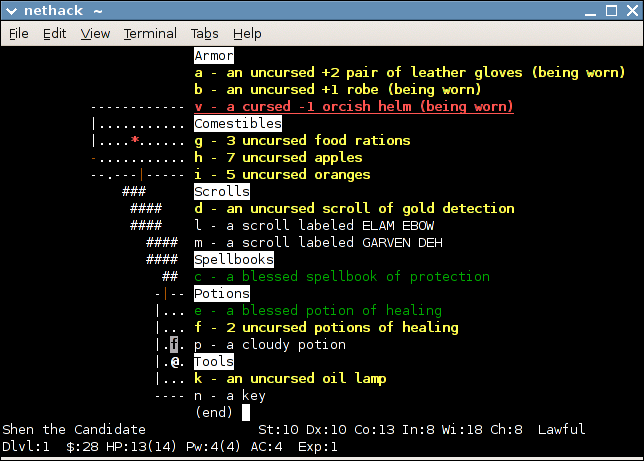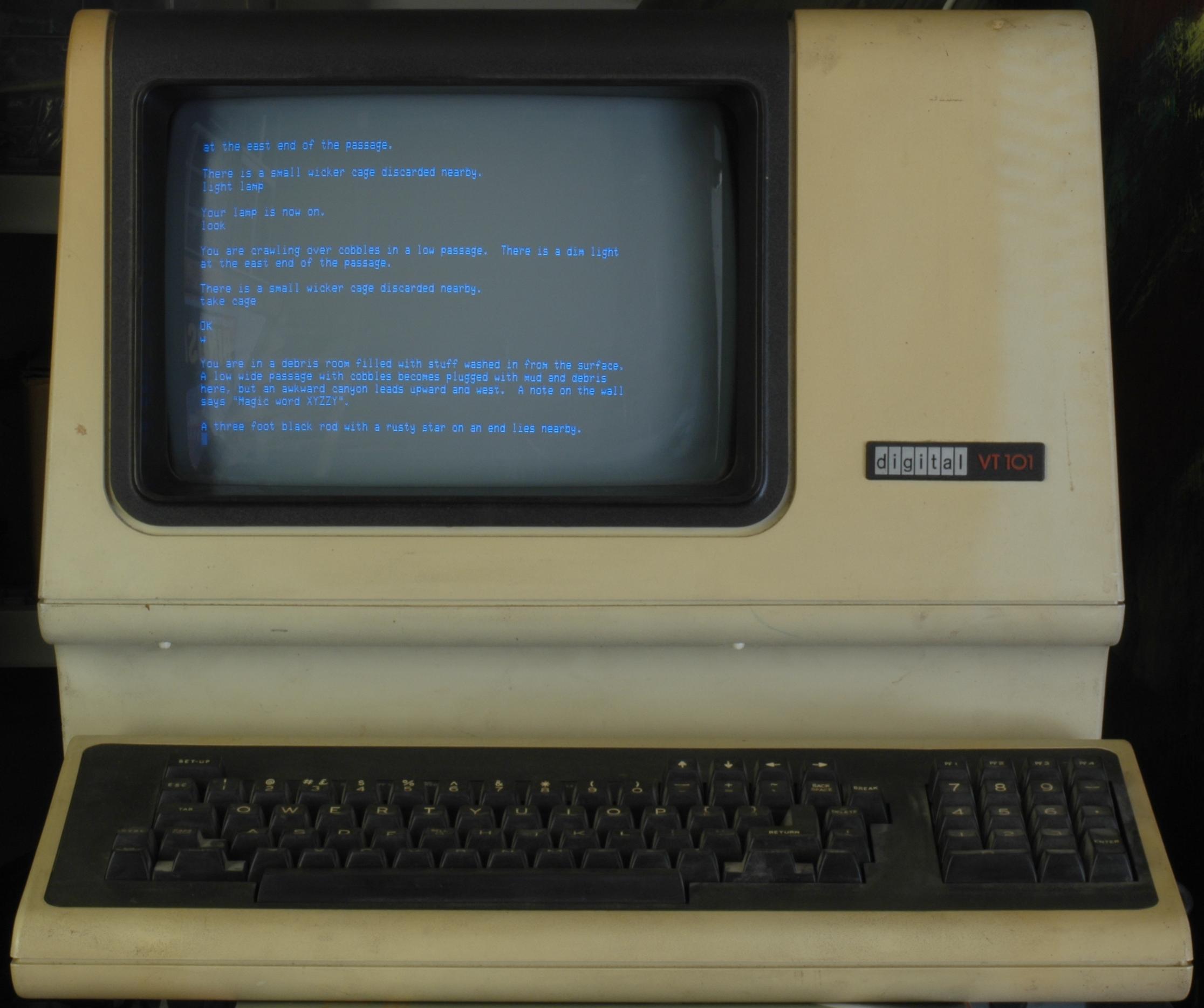|
Ttyrec
ttyrec is a program or its file format capable of recording the TTY output of a text-mode program together with timestamps and then replaying it. It is widely used for example in the ''NetHack'' community for storing game replays. It is similar to the script command, but also allows for pausing, slowing down or speeding up playback. It can also stream the recording on the network and be used to transfer files with uudecode. Recorders and players * original ''ttyrec'' (Unix) * ''Term::TtyRec'' (Perl) * ''Term::TtyRec::Plus'' (Perl) * ''Tie::Handle::TtyRec'' (Perl) * ''termrec'' (Win32, Unix) Playback only * ''TTYPLAYER'' (Java) * ''IPBT'' (Unix) Technical file format specification Each chunk consists of a header using 32bit unsigned little-endian numbers: * sec – seconds, either since the beginning of the recording (0-based) or since the Unix epoch * usec – 0..999999 microseconds * len – length of the payload and the actual payload written as text ... [...More Info...] [...Related Items...] OR: [Wikipedia] [Google] [Baidu] |
Script (Unix)
The script command is a Unix utility that records a terminal session. It dates back to the 1979 3.0 BSD. Usage A script session is captured in file name by default; to specify a different filename follow the command with a space and the filename as such: . The recorded format of consists of plain-text timing information (for the whole session) and verbatim command output, including whatever ANSI escape code the program has printed for formatting. It uses a pseudoterminal for this purpose, so programs act exactly as if they were on a terminal. The util-linux command offers a replay function to its script, which supports using an extra timing file for character-level information. Some online services, such as the now-defunct shelr.tv, can also show the format as a low-bandwidth alternative to video screencasts. Problems with ''script'' One of the problems with the script command is that it only allows logging of a child process; and often there is a need to log the comma ... [...More Info...] [...Related Items...] OR: [Wikipedia] [Google] [Baidu] |
File Format
A file format is a standard way that information is encoded for storage in a computer file. It specifies how bits are used to encode information in a digital storage medium. File formats may be either proprietary or free. Some file formats are designed for very particular types of data: PNG files, for example, store bitmapped images using lossless data compression. Other file formats, however, are designed for storage of several different types of data: the Ogg format can act as a container for different types of multimedia including any combination of audio and video, with or without text (such as subtitles), and metadata. A text file can contain any stream of characters, including possible control characters, and is encoded in one of various character encoding schemes. Some file formats, such as HTML, scalable vector graphics, and the source code of computer software are text files with defined syntaxes that allow them to be used for specific purposes. Specifications ... [...More Info...] [...Related Items...] OR: [Wikipedia] [Google] [Baidu] |
Text Terminal
A computer terminal is an electronic or electromechanical hardware device that can be used for entering data into, and transcribing data from, a computer or a computing system. The teletype was an example of an early-day hard-copy terminal and predated the use of a computer screen by decades. Early terminals were inexpensive devices but very slow compared to punched cards or paper tape for input, yet as the technology improved and video displays were introduced, terminals pushed these older forms of interaction from the industry. A related development was time-sharing systems, which evolved in parallel and made up for any inefficiencies in the user's typing ability with the ability to support multiple users on the same machine, each at their own terminal or terminals. The function of a terminal is typically confined to transcription and input of data; a device with significant local, programmable data-processing capability may be called a "smart terminal" or fat client. A term ... [...More Info...] [...Related Items...] OR: [Wikipedia] [Google] [Baidu] |
Text User Interface
In computing, text-based user interfaces (TUI) (alternately terminal user interfaces, to reflect a dependence upon the properties of computer terminals and not just text), is a retronym describing a type of user interface (UI) common as an early form of human–computer interaction, before the advent of modern conventional graphical user interfaces (GUIs). Like GUIs, they may use the entire Electronic visual display, screen area and accept mouse (computing), mouse and other inputs. They may also use color and often structure the display using special graphical Character (computing), characters such as ┌ and ╣, referred to in Unicode as the "box drawing" set. The modern context of use is usually a terminal emulator. Types of text terminals From console application, text application's point of view, a text screen (and communications with it) can belong to one of three types (here ordered in order of decreasing accessibility): # A genuine text mode display, controlled by a ... [...More Info...] [...Related Items...] OR: [Wikipedia] [Google] [Baidu] |
NetHack
''NetHack'' is an open source single-player roguelike video game, first released in 1987 and maintained by the NetHack DevTeam. The game is a fork of the 1982 game ''Hack'', itself inspired by the 1980 game '' Rogue''. The player takes the role as one of several pre-defined character classes to descend through multiple dungeon floors, fighting monsters and collecting treasure, to recover the "Amulet of Yendor" at the lowest floor and then escape. As an exemplar of the traditional "roguelike" game, ''NetHack'' features turn-based, grid-based hack and slash dungeon crawling gameplay, procedurally generated dungeons and treasure, and permadeath, requiring the player to restart the game anew should the player character die. The game uses simple ASCII graphics by default so as to display readily on a wide variety of computer displays, but can use curses with box-drawing characters, as well as substitute graphical tilesets on machines with graphics. While ''Rogue'', ''Hack'' and other e ... [...More Info...] [...Related Items...] OR: [Wikipedia] [Google] [Baidu] |
Little-endian
In computing, endianness, also known as byte sex, is the order or sequence of bytes of a word of digital data in computer memory. Endianness is primarily expressed as big-endian (BE) or little-endian (LE). A big-endian system stores the most significant byte of a word at the smallest memory address and the least significant byte at the largest. A little-endian system, in contrast, stores the least-significant byte at the smallest address. Bi-endianness is a feature supported by numerous computer architectures that feature switchable endianness in data fetches and stores or for instruction fetches. Other orderings are generically called middle-endian or mixed-endian. Endianness may also be used to describe the order in which the bits are transmitted over a communication channel, e.g., big-endian in a communications channel transmits the most significant bits first. Bit-endianness is seldom used in other contexts. Etymology Danny Cohen introduced the terms ''big-endian' ... [...More Info...] [...Related Items...] OR: [Wikipedia] [Google] [Baidu] |
Unix Epoch
Current Unix time () Unix time is a date and time representation widely used in computing. It measures time by the number of seconds that have elapsed since 00:00:00 UTC on 1 January 1970, the beginning of the Unix epoch, less adjustments made due to leap seconds. Unix time originated as the system time of Unix operating systems. It has come to be widely used in other computer operating systems, file systems, programming languages, and databases. Definition Two layers of encoding make up Unix time. The first layer encodes a point in time as a scalar real number which represents the number of seconds that have passed since 00:00:00UTC on Thursday, 1 January 1970. The second layer encodes that number as a sequence of bits or decimal digits. Unix time differs from both Coordinated Universal Time (UTC) and International Atomic Time (TAI) in its handling of leap seconds. UTC includes leap seconds that adjust for the discrepancy between precise time, as measured by atomic clock ... [...More Info...] [...Related Items...] OR: [Wikipedia] [Google] [Baidu] |
Vt100
The VT100 is a video terminal, introduced in August 1978 by Digital Equipment Corporation (DEC). It was one of the first terminals to support ANSI escape codes for cursor control and other tasks, and added a number of extended codes for special features like controlling the status lights on the keyboard. This led to rapid uptake of the ANSI standard, which became the de facto standard for hardware video terminals and later terminal emulators. The VT100 series, especially the VT102, was extremely successful in the market, and made DEC the leading terminal vendor at the time. The VT100 series was replaced by the VT200 series starting in 1983, which proved equally successful. Ultimately, over six million terminals in the VT series were sold, based largely on the success of the VT100. Description DEC's first video terminal was the VT05 (1970), succeeded by the VT50 (1974), and soon upgraded to the VT52 (1975). The VT52 featured a text display with 80 columns and 24 rows, bidirection ... [...More Info...] [...Related Items...] OR: [Wikipedia] [Google] [Baidu] |
Control Codes
In computing and telecommunication, a control character or non-printing character (NPC) is a code point (a number) in a character set, that does not represent a written symbol. They are used as in-band signaling to cause effects other than the addition of a symbol to the text. All other characters are mainly printing, printable, or graphic characters, except perhaps for the "space" character (see ASCII printable characters). History Procedural signs in Morse code are a form of control character. A form of control characters were introduced in the 1870 Baudot code: NUL and DEL. The 1901 Murray code added the carriage return (CR) and line feed (LF), and other versions of the Baudot code included other control characters. The bell character (BEL), which rang a bell to alert operators, was also an early teletype control character. Control characters have also been called "format effectors". In ASCII There were quite a few control characters defined (33 in ASCII, and the ECM ... [...More Info...] [...Related Items...] OR: [Wikipedia] [Google] [Baidu] |
Joey Hess
Joey may refer to: People *Joey (name) Animals * Joey (marsupial), an infant marsupial * Joey, a Blue-fronted Amazon parrot who was one of the Blue Peter pets Film and television * ''Joey'' (1977 film), an American film directed by Horace Jackson * ''Joey'' (1985 film), a German horror film directed by Roland Emmerich * ''Joey'' (1986 film), an American film directed by Joseph Ellison * ''Joey'' (1997 film), an Australian film directed by Ian Barry * ''Joey'' (TV series), a spin-off of the popular ''Friends'' television series Music * ''Joey'' (album), 2014 album by Danish singer Joey Moe * "Joey" (Bob Dylan song), from the 1976 album ''Desire'' * "Joey" (Concrete Blonde song), a song by Concrete Blonde from their 1990 album ''Bloodletting'' * "Joey" (Sugarland song), by Sugarland from their 2008 album ''Love on the Inside'' * "Joey", a 1954 song by Betty Madigan * "Joey", a song by Bon Jovi from their 2002 album ''Bounce'' Sports * Joey, a type of return in picklebal ... [...More Info...] [...Related Items...] OR: [Wikipedia] [Google] [Baidu] |

_en.png)



